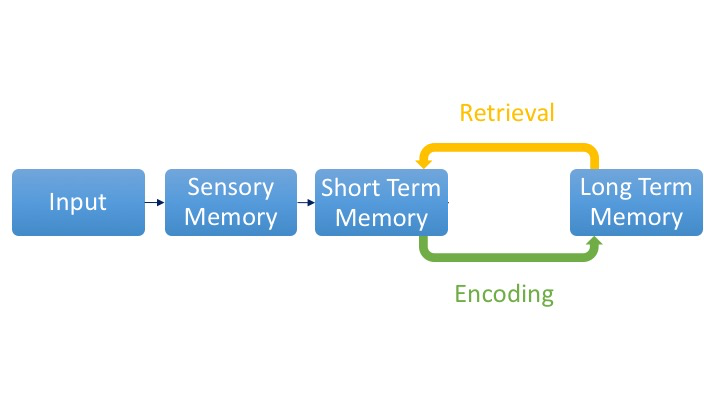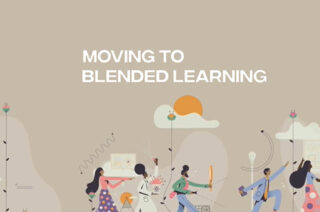Factsheet: How Students Learn

Introduction
A knowledge of the way students learn can help us design effective courses and help us to advise and guide our students. While the literature on this topic is vast, there are a few key pieces of experimental work that everyone who designs or changes courses should know, these are:
- Cognitive load theory & how memory works
- Active learning
- The testing, spacing, worked-example, and interleaving effects
- The work around effective feedback
- Outcomes based education & constructive alignment
- Motivation and peer effects
If you want a much broader list of experimental work along with its impact on student achievement the Visible Learning Partnership keeps a list of over 250 influences on student achievement – the descriptions of each item are detailed in Visible Learning: A Synthesis of Over 800 Meta-Analyses Relating to Achievement.
What is this? What problems does this solve?
While there are some hints and tips for things you can immediately apply to your teaching, reading up on these topics is going to give you a deeper understanding of why many of the teaching techniques work (and why many do not!).
I will attempt to briefly present the 6 key areas below but other sources like Hattie & Yates 2013 (for cognitive load, testing effect, feedback, and motivation), Mayer 2014 (for cognitive load, active learning, testing effect) and Biggs & Tang 2011 (constructive alignment) explain these with more detail and clarity than I can. If you do read these books I suggest skipping to these sections first. What I have outlined below is, in places, grossly oversimplified but should be enough to give you a rough idea of how students learn.
How memory works

Image source: Dkahng / CC-BY-SA-4.0
If we are paying attention to the information in our sensory memory then it will enter our working (AKA short term) memory. Working memory is where conscious thought takes place, including problem solving, thinking, and learning. Our working memory is seriously limited, young adults can only hold 3-5 “chunks” at any one time [Cowan 2010] and it only lasts of the order of seconds without being refreshed (think of repeating a phone number over and over until you can find somewhere to write it down).
A chunk can be thought of as a single “unit” of memory, this might be a number (e.g. 24), an entire phrase (“she sells sea shells on the sea shore”), or an entire chess board layout (e.g. Sicilian Defense) depending on what is stored in our long term memory. In other words, the facts and concepts we have in long term memory effectively increase the space available in working memory, thus our prior knowledge is one of the biggest determinants of learning speed (See: Chapter 1 of “How learning works” Ambrose et. al. 2010). Applied to another context: real-world problem solving and creativity are strongly dependent on the availability of accurate knowledge and the ease with which it can be handled in working memory, both of which are dependent on what we have stored in our long term memory.
One other thing to note is that there are two pathways in our working memory: pictorial and verbal [see: Dual coding theory in Chapter 4 of Mayer 2014] – thus we can further maximize working memory by using both channels for separate information (e.g. don’t put text [verbal] on powerpoint slides [pictorial]).

Image source: Mcmactavish / CC-BY-SA-4.0
To remember something requires that (1) it was encoded in long-term memory in the first place and (2) you can retrieve it. To encode a memory students need to be thinking deeply about the topic, forming links to other items in long term memory, this memory will also need periodic refreshing to be retrievable (see the section below on testing).
The format that we learn something will also impact how easily we retrieve it e.g. If I taught someone the dates that each king of England reigned for, they have the information in long term memory to tell me all the Kings who reigned for over 40 years but they cannot retrieve this, as that is not how it is stored. The same might still be true if we explicitly told them the lengths of their reigns (depending on whether the student has previously thought about grouping the kings by how long they reigned). See Chapter 2 of Ambrose et al 2010).
The facts about encoding and retrieval mean we should help students form and test a variety of links between new material and prior knowledge in a way that is similar to the way we want them to retrieve it.
Chapter 2 of Mayer 2014 (The Cambridge Handbook of Multimedia Learning) or Chapter 13 & 14 of Hattie & Yates 2013 (Visible Learning and the science of how we learn) presents this in more detail and with more discussion of the consequences for teaching.
Cognitive load theory
We said that working memory is limited to 3-5 chunks but there is another important facet to this. Some of our working memory will be devoted to things other than the concepts we want the students to learn – this greatly decreases their ability to learn material.
People cannot multitask when learning (Chapter 20 of Hattie & Yates 2013), multitasking basically involves switching rapidly between tasks, and either clearing out working memory (i.e. stopping thinking about the teaching material) or devoting some working memory to the other task (i.e. reducing the available working memory for learning). Thus students who are chatting socially, playing on their phones, or browsing the web are at a great disadvantage when trying to learn (e.g. in a lecture, or at home).
But it’s not just the students, the way we design our learning contributes to cognitive load (the filling up of working memory). If we design tasks that require students to think about things that are not necessary for learning the material then we are limiting the working memory available for learning. This extraneous cognitive load might be in the form of games or activities that are fun and active (but unnecessary). It might also be in the form of having split information onto different pages of the course notes – the students have to keep flicking back and forth to understand it.
Finally, we can minimise the cognitive load by careful ordering (sequencing) of our material. Relevant prior knowledge acts to decrease our cognitive load, therefore if we explicitly find links to material students already know and present topics one at a time, building upon one another, we can increase learning efficiency.
Chapter 2 of Mayer 2014 or Chapter 13 – 16, and 20 of Hattie & Yates 2013 presents this in more detail and with more discussion of the consequences for teaching.
Active learning
Although it was stated before it is worth making this point explicit – there is no such thing as passive learning – “Memory is the residue of thought” (Daniel Willingham). To think, and thus to learn, requires motivation, time, attention, and effort. Thus we want to design our learning activities (as much of the study hours as possible) around tasks that get students to think deeply about the material. Sitting in a lecture or reading a book can be done without any real focus and, if that is the case, no significant learning will take place.
“Learning results from what the student does and thinks and only from what the student does and thinks. The teacher can advance learning only by influencing what the student does to learn”.
Herbert Simon
There is one subtlety to highlight here – ‘active’ doesn’t necessarily mean physically active. A student might be ‘solving’ a question sheet by mechanically copying down past answers without really thinking about why they work – this is ‘active’ compared to sitting in a lecture but it is not helpful. In the same way a student who is staring into space in a lecture might be thinking deeply about the material.
What we want is psychological activity, in other words, thought. But the only way to know if the right kind of thought is happening is to make the learning visible.
We make learning visible by seeing the output of students thought. This might be in the form of answers from classroom response systems or by getting students to hand in their answers to question sheets, or by walking round a class and listening to their group discussions. This does not mean we have to mark and give feedback on all their work, we just need to see how they are doing and the types of mistakes they are making. This type of information from the students, is the most important type of feedback [Hattie & Timperley 2007].
The testing, spacing, worked-example, and interleaving effects
“Proficiency requires practice”
(Daniel Willingham)
Students who spend their time practising learn significantly more than those who spend their time re-reading, highlighting, or even summarising their notes/textbook/lecture recordings – this is called the testing effect. This finding holds true across a range of abilities and in many different tasks and educational contexts. Thus we should be designing our courses to increase the amount of time a student can spend practicing.
In this context, practicing might involve MCQs spaced throughout lectures, a large bank of practice problems, having a recap quiz at the start of every lecture, mock exams, etc., etc. Again, the focus is not on marking, the focus is on the student being forced to test their retrieval from long term memory.
To make best use of this effect the questions should start easy and gradually become harder. Students who are provided with fully worked examples do a lot better than those who do not (see: worked example effect). Fully worked examples are questions where the full working is shown along with the solution. These greatly help students, both in learning how to solve similar problems but also, by applying the methods they have seen to new problems, it helps them learn to generalise the technique (i.e. by combining fully worked examples and independent practice many more students will achieve deep learning).
Students will retain their knowledge for longer through spaced rather than massed practice (see: spacing effect / spaced repetition). In other words, students who cram (studying everything in a short space of time) will not remember as much as those who repeatedly retest themselves. To do this most efficiently the material should be revisited on an expanding timeframe, e.g. 1 day, 3 days, 1 week, 2 weeks, 1 month, 2 months, 6 months, etc.
Finally, students will be better able to solve new problems if, when they practice, they mix up questions from previous topics rather than studying questions from each week of material separately (see: interleaving effect).
These four effects mean that we should regularly give students opportunities to test themselves on problems randomly selected from all the material they have previously looked at. We should also be providing a bank of fully solved questions, for students to learn from.
Chapter 16 of Mayer 2014 or Part 3 of Evidence Based Training Methods (2014) Ruth Colvin Clark are good overviews of the worked example effect. Gwern provides a thorough review of the research on spaced repetition (including interleaving and the testing effect) or see the relevant sections of Dunlosky, John, et al. 2013.
Feedback
Feedback has one of the largest average effects in all of education. In other words, studies on feedback generally see one of the largest improvements in student marks when compared to any other type of educational intervention. But it’s not all good news, over a third of educational research on feedback shows feedback to have a negative effect (i.e. the students who had the “improved” feedback did worse!).
Thus it is important to know what counts as effective feedback and how this relates to student learning.
- External rewards, praise and punishment are all associated with either no change or a significant reduction in achievement, i.e. in many studies rewards, praise and punishment reduced student learning.
- Motivation cues (e.g. encouragement) have a hugely positive effect on student learning (e.g. “you are on the right lines, keep going”, “I am giving you this feedback because I think you can do really well in this class and I want to help you get there”).
- Information that tells the student what they need to do next to improve is also a highly positive effect on student learning. (e.g. “try this next”).
- It is valuable to tell students what they got correct and incorrect (e.g. ticks and crosses, and other information about how they are doing).
- Effective feedback is targeted at the work (“try this”) not the person (“you are …”).
- It doesn’t seem to matter whether the feedback is written, oral, video, or even from an automated computer system.
- It doesn’t even matter how often feedback is given. To save your time and sanity I would recommend focusing on quality rather than quantity.
- Giving grades along with feedback significantly reduces the positive effect of the feedback – grades effectively tell the student “the work is over”.
- Feedback is only valuable if acted upon. A student must change their behaviour because of the feedback, otherwise it is not effective (it’s not doing anything at all).
As feedback is only valuable if acted upon, we need to help our students do just that. They need help to read and understand the feedback and have an opportunity to put that feedback into practice. Students often do not know how to interpret and use the feedback they have been given and it is valuable to teach them “feedback literacy”.
It also means feedback needs to be embedded into cycles of practice (testing) and feedback – “all students regardless of their level of achievement typically need to be exposed to any new learning at least three to five times before it has a high probability of being learnt.” Visible Learning Feedback (Chapter 1). Thus we should design course that have an opportunity for a student to immediately act upon the feedback.
The best resource for learning about effective feedback is either the book Visible Learning Feedback, or the systematic review of meta-analyses that this book was based upon The Power of Feedback. There is a very brief overview of this work in Chapter 8 of Hattie & Yates 2013. We also have an effective feedback factsheet.
Outcomes based education / constructive alignment
Outcomes based education is the idea that what matters is not what we teach (syllabus/content) but what the student learns (outcomes). Hopefully the value of this is obvious but it does shift the focus when designing our courses to things that we know improve learning (reducing cognitive load, active learning, worked examples and regular non-graded testing and feedback).
That’s not to say that “what we teach” isn’t important, it matters a lot – but it should be driven by the outcomes we want to see. Given what has been said above about the importance of focusing the students’ attention solely on concepts and practice that are relevant to their learning it becomes even more important to know what we want them to learn to do!
Students knowing these learning intentions (outcomes) causes a significant improvement in student achievement (d=0.59, Visible Learning Feedback Chapter 2). This is because it helps them direct their effort and attention to the correct areas.
Constructive alignment and outcomes based education is described in more detail in Biggs & Tang 2011.
Motivation and peer effects (social)
Learning cannot happen without a student spending a lot of time thinking deeply about the material and they need the motivation to put in the time and effort. Thus motivation has a large effect on learning.
There are three key components to motivation, if any one of them is lacking a student is unlikely to put in the time and effort:
- Value. Will putting time and effort in lead to something good? Either because they will enjoy doing it (intrinsic value), they will enjoy completing it (attainment value) or they will value what it leads to (extrinsic/instrumental value).
- Expectancy. How likely is it that the student will ‘get’ the value. If a student doesn’t believe they can put in enough time/effort they lack efficacy expectancy but if a student believes that however much time/effort they put in they won’t succeed then they lack outcome expectancy (e.g. “I’m just bad at Maths”). See Chapter 24 and 25 of Hattie & Yates 2013.
- Supportiveness of the environment. The environment around a student might be filled with distractions or reminders and the student’s peers might provide explicitly pressure or encouragement, or an implicit expectation towards or away from certain behaviours. This social aspect is a huge determinant of behaviour.
One final point to add about motivation is that it is relative. Even if you have low motivation for a task, as long as everything else you could do is even lower, you will still perform it.
Not only is our behaviour largely determined by social effects (roughly we do what we think “most people who are important to us think that we should/should not do”) Webb & Sheeran 2006 but “one of the ways in which humans learn most efficiently and effectively is when learning is situated within the social context” Encyclopedia of the Sciences of Learning (2012). This is why cooperative learning “has very strong effects on a range of dependent variables such as achievement, socialization, motivation, and personal self-development.” Gillies 2016.
Thus motivation is high when students can see a gap in their knowledge that they perceive as valuable and feasible to fill and they work within a supportive social environment.
To address value:
- Be enthusiastic – students are more likely to value something if you show that you value it (see: Goal Contagion).
- Make sure the student understands the learning outcomes and discuss the value of learning these topics (what exciting skills and jobs does learning this lead to).
To address expectancy:
- Make sure the student has a clear idea of what the learning outcomes and success criteria are and what they need to do to achieve them. Part of this is having clear marking criteria and discussing examples of good and bad work, part of this is guiding the students through how they should spend their study hours.
- Sequence the learning activities so that students can see progress, this gives them valuable information about the feasibility of learning this topic. In other words make sure the learning activities are at an appropriate level of difficulty.
- Provide motivational feedback (encouragement) as a student progresses through the course. But this cannot succeed without activities that are actually achievable for the student, the best way to improve someone’s confidence in a task is for them to repeatedly succeed in that task.
To address the social environment:
- Model the desired behaviour. If you want students to notice certain things when solving questions then solve the questions while “thinking out loud”. If you want them to critically review papers, actually do that in front of them rather than just telling them how to. Students will learn to imitate the behaviour and it is more effective than just telling them how you would solve something (without actually showing you doing it).
- Encourage students to teach each other – either formally or informally. This not only sets a climate and social expectation of learning but helps the student-teacher to cement their knowledge while teaching the recipient (see: peer learning).
- Create activities that encourage student interaction (see: cooperative learning or kagan structures).
For an overview of motivation, Chapter 3 of Ambrose et. al. 2010 is probably the best place to start, followed by Visible Learning Feedback. A comprehensive overview of motivation is given in the Oxford handbook of human motivation, which has a relevant chapter on Motivation in Education. For an overview of peer and cooperative learning see Gillies 2016.
Where can I learn more?
Depending on what you want to learn you can find links to relevant resources in the sections above. If you are not sure where to start, I suggest reading the resources in this order:
- Ambrose et. al. 2010. As with the list above it picks a few of the most important findings in educational research, but spends a lot more time on practical suggestions based upon the evidence.
- Hattie & Yates 2013. This provides a much broader look at the field, by necessity this means each topic is covered in less detail but this will give you a good general framework for how students learn and help you judge the effectiveness of teaching techniques in general. If you wanted to continue down this line of inquiry I would recommend a previous book by Hattie (Visible Learning: A Synthesis of Over 800 Meta-Analyses). Kraft 2018 will give you a much more nuanced view of what effect sizes can tell us and should be read alongside the Synthesis of Meta-Analysis.
- Clark 2014 provides an accessible and actionable overview of the research on effective explanations and a little on effective practice. If you want a more academically rigorous treatment of the same topic see Mayer 2014. A short summary of the research findings is given on page 8-9 of Chapter 1 of Mayer 2014.
- Visible Learning Feedback is a research based and actionable review of how to design courses that contain effective two-way feedback. This ends up covering the testing effect/spaced repetition and a fair amount on student motivation. If you want an academically rigorous treatment of the same topic see the systematic review of meta-analyses that this book was based upon (The Power of Feedback).
- Study Strategies to Boost Learning (Dunlosky 2013) is an excellent review of the advice to students but also contains a review of the work around practice (testing, spacing, interleaving etc.). Table 1 is an excellent summary of the effectiveness of studying techniques. If you want an academically rigorous treatment of the same topic see Dunlosky, John, et al. 2013.
To help you put some of the approaches to learning (e.g. behaviourism, constructivism) in context you might want to read Brown 2004, but I have personally found the above books far more useful to my teaching practice and my understanding of how students learn.
Next steps
If you want to discuss education research or practice contact james.brooks-3@manchester.ac.uk. If there is enough interest I will set up an informal reading/discussion group.
Things to look out for (caveats & warnings)
The main caveat to give to taking ideas from any research paper is that implementation matters. Just because something works well in theory, or even in practice, doesn’t mean it will work in your context or the way you have chosen to implement it. There is a lot of disagreement in the literature and it’s often not clear who is right (or, more accurately, under which sets of circumstances each is better). It’s always best to find someone who has used the technique you want to try and discuss your plans with them beforehand. The eLearning team should be your first point of contact if you don’t know where to start.
The final piece of advice comes from another body of research – pedagogic content knowledge. This is the idea that there are three skillsets you need to be a good teacher:
- Content Knowledge – knowledge of your subject.
- Pedagogic Knowledge – knowledge of how students learn and of good teaching practices.
- Pedagogic Content Knowledge (PCK) – knowledge of how to teach your subject.
This final piece PCK, involves (1) knowing the mistakes that students often make, their misconceptions, their prior knowledge, and (2) having a variety of explanations and exercises for the content that takes into account the students prior knowledge and directly addresses their misconceptions.
PCK is at least as important as pedagogic knowledge and so we should be spending time developing this, by seeing student progress/mistakes and by looking for and thinking of better/different ways to explain our material. We cannot become excellent educators without knowledge and skill in all three domains.


